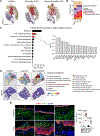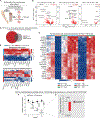Metabolic coordination between skin epithelium and type 17 immunity sustains chronic skin inflammation
- PMID: 38772365
- PMCID: PMC11236527
- DOI: 10.1016/j.immuni.2024.04.022
Metabolic coordination between skin epithelium and type 17 immunity sustains chronic skin inflammation
Abstract
Inflammatory epithelial diseases are spurred by the concomitant dysregulation of immune and epithelial cells. How these two dysregulated cellular compartments simultaneously sustain their heightened metabolic demands is unclear. Single-cell and spatial transcriptomics (ST), along with immunofluorescence, revealed that hypoxia-inducible factor 1α (HIF1α), downstream of IL-17 signaling, drove psoriatic epithelial remodeling. Blocking HIF1α in human psoriatic lesions ex vivo impaired glycolysis and phenocopied anti-IL-17 therapy. In a murine model of skin inflammation, epidermal-specific loss of HIF1α or its target gene, glucose transporter 1, ameliorated epidermal, immune, vascular, and neuronal pathology. Mechanistically, glycolysis autonomously fueled epithelial pathology and enhanced lactate production, which augmented the γδ T17 cell response. RORγt-driven genetic deletion or pharmacological inhibition of either lactate-producing enzymes or lactate transporters attenuated epithelial pathology and IL-17A expression in vivo. Our findings identify a metabolic hierarchy between epithelial and immune compartments and the consequent coordination of metabolic processes that sustain inflammatory disease.
Keywords: HIF1α; epithelium; glycolysis; inflammation; lactate; metabolism; skin; type 17 cells.
Copyright © 2024 Elsevier Inc. All rights reserved.
Conflict of interest statement
Declaration of interests I. Subudhi, P.K., and S.N. have filed a provisional patent for HIF1α inhibition in inflammatory skin diseases (U.S. serial number 63/540,794, filed September 27, 2023). N.A. is a consultant for Immunitas, 23 and me, Cellino Pharmaceuticals, and Janssen and serves on the SAB of Shennon Bio. S.N. is on the SAB of Seed Inc., is a consultant for BiomX, and receives funding from Takeda Pharmaceuticals. This activity is not relevant to the content of this manuscript.
Figures







Comment in
-
Skin deep: Epithelial cell metabolism and chronic skin inflammation.Immunity. 2024 Jul 9;57(7):1451-1453. doi: 10.1016/j.immuni.2024.06.004. Immunity. 2024. PMID: 38986439
References
-
- Nograles KE, Zaba LC, Guttman-Yassky E, Fuentes-Duculan J, Suarez-Farinas M, Cardinale I, Khatcherian A, Gonzalez J, Pierson KC, White TR, et al. (2008). Th17 cytokines interleukin (IL)-17 and IL-22 modulate distinct inflammatory and keratinocyte-response pathways. Br J Dermatol 159, 1092–1102. 10.1111/j.1365-2133.2008.08769.x. - DOI - PMC - PubMed
Publication types
MeSH terms
Substances
Grants and funding
LinkOut - more resources
Full Text Sources
Medical
Molecular Biology Databases

